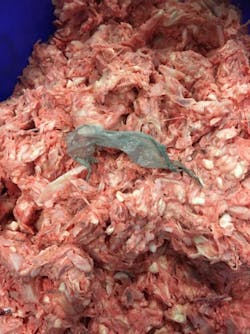Many of the standard practices of doing business — especially in the food & beverage industry — can find equivalencies in hunting. Companies are always searching for business opportunities, finding innovative product ideas, discovering a way to increase operational efficiencies — looking for the slightest advantage to get ahead.
Of course, not all crucial hunting parties are searching for growth. Some are looking for ways to correct issues. And that’s where metal detection and X-ray inspection come into play. It’s a task all processing plants must embark upon minute after minute: the detection and elimination of any foreign material in the product stream.
These contaminants — including but not limited to pieces of metal, wood, plastic, rubber and any other non-food material — could injure or sicken consumers who purchase the product.
Fortunately, the industry is always on the hunt for improved technology to help make detection and inspection more foolproof. The technology has come a long way, explains Andrew Lorenz, president and CEO of We R Food Safety! (www.werfoodsafety.com), but there remain challenges to finding the smallest contaminants.
According to John Klinge, global product manager-metal detection for Eriez (www.eriez.com), it’s critical that end users, integrators and engineering firms work closely with equipment manufacturers to understand both the capabilities and limitations of inspection technology to keep plants running efficiently and producing safe product.
“There’s always a balance between detecting smaller and smaller pieces of tramp metal or foreign contaminants without causing ‘false detections’ and compromising production,” Klinge says. Furthermore, high worker turnover means training on the technology must be ongoing to keep all up to speed.
Of course, that assumes the facility or company has made foreign-material elimination a high enough priority in its food safety plans. Jeff Youngs, president and CEO for ProSpection Solutions (www.prospectionsolutions.com), says corporate commitment is the first step before implementation.
“Getting plants and processors to make reducing foreign material a top priority before a detrimental recall occurs remains a big roadblock,” he says. After the company has committed itself to the cause, it can still be a challenge “implementing the correct application at the proper locations to reduce, identify and remove foreign material throughout the process.”
X-ray inspection can help, says Geri Foley, product line manager-X-ray for Mettler Toledo (www.mt.com), but it also has its limitations when it comes to bone, wood and plastic, for example.
“These are very challenging materials to find — the less dense a contaminant, the more difficult it can be to detect,” she explains. “There have been innovations in technology to eliminate ‘noise’ in the product itself which can improve detection capability of foreign materials.”
Youngs relays that advances in the technology have produced inspection equipment that can identify low-density foreign material that X-ray and metal detection systems cannot. He and Lorenz both cite innovations in grinding equipment that can remove bone, wood and plastic during the grinding process. In addition, Klinge says processors can make changes to their plastics and rubber use along the processing lines to help minimize the threat of contamination.
“A solution would be to implement detectable plastics and rubber [along the processing lines] by working with companies that incorporate metal- or X-ray-detectable additives to the rubber or plastic parts to create scrapers, gaskets, belting, etc.”
“Stainless steel is more difficult to detect than ferrous and non-ferrous metals,” he explains. “And the equipment used on the production lines is typically made of stainless steel (such as mixers, etc.), which eventually break down and small shards can enter into the product.”
According to Lorenz, employees also can inadvertently introduce contaminants into the product stream if they are not properly trained, even on the most obvious tasks.
“Ultimately the best way is to avoid the contamination event in the first place by training employees on how to properly open plastic bags and dump product, assuring wood never goes directly over product, and other tasks that carry contamination risk,” he says. Even with a preventive approach, Youngs says, inspection systems are imperative for processors to avoid gambling with odds stacking higher against them.
“With the growth in automation, processing equipment and increased food production, there is a higher chance of machinery and manufacturing parts entering the processing cycle,” he adds. “Plants should work with a company that will listen to their issues and risks and help them identify the best solution to minimize those threats before they happen.”
Rarely is there a “one size fits all” solution, and employees need to know the issues in front of them that depend on the food or beverage product being processed, Klinge says.
“Education of the current technologies specific to certain applications is very important,” he says. “Oftentimes, many technologies need to work in tandem to minimize risk to consumers.”
Product temperature, moisture, salt content, format, size and shape all can reduce detection capability, Davis adds. “Depending on what product is being manufactured, using metal detectors specifically designed for the product and conditions can improve detection sensitivity,” he says.
Klinge reminds processors that multiple solutions may be necessary at multiple points in the process. “Various risk mitigation technologies should be incorporated throughout the entire production process, not just at the end of the line packaging,” he says. “Equipment suppliers can conduct full plant audits to assist with implementing the proper foreign body removal and inspection technologies.”
Keri Klein, product line manager-check weighing and vision for Mettler Toledo, agrees with a strategy that institutes multiple points of inspection, with vision systems inspecting packaged goods for mislabeling issues (such as incorrect allergen information), metal detectors and X-ray systems safeguarding against foreign materials, and in-line checkweighers preventing under-filled packages from making it to customers.
Klinge believes detection equipment manufacturers should implement full traceability and accountability within the technology, even digitally recording that the daily or hourly verification checks have been completed.
All these advances can make a difference as long as the food and beverage processors don’t hesitate or wait for an issue to arise. Lorenz says processors should have robust metal detection and imaging systems in place, and Youngs agrees that the time is now, before something breaks and causes a recall or worse.
“It is critical that foreign material reduction, identification and removal is taken seriously,” he says. “Instead of putting inspection technology on one line or outsourcing inspection, it is imperative to have this technology on every line.”
Covering all risk points and keeping all eyes on the status of the equipment and parts in the plant will help food and beverage processors hunt down foreign material before it enters the product stream.




